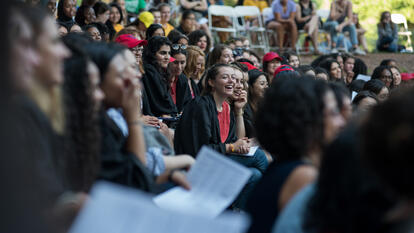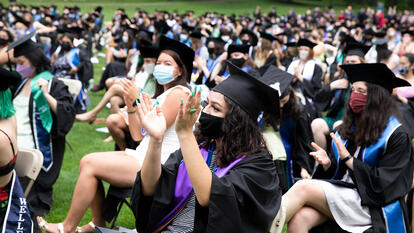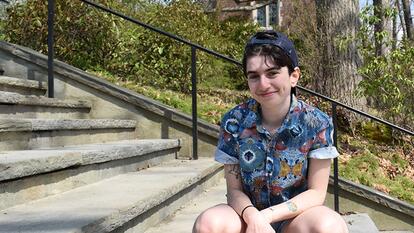March 17 Marked the 104th Anniversary of the College Hall Fire

On March 17, 1914, Wellesley’s College Hall was engulfed by a massive fire that totally destroyed the building in four hours. Fortunately, there were no injuries or lives lost.
Wellesley Professor Martha Hale Shackford, Class of 1896, witnessed the fire and wrote an account for the April 2, 1914, edition of the Wellesley College News. “Tongues of flames that had been creeping around the ceilings and walls, curling in and out of the balustrades of the staircases, leaped into tempestuous waves,” she wrote. “The palms shriveled and cracked, sending out strange colors as they disappeared.”
Ten months later, construction began on Tower Court, in the footprint of College Hall. Now, 104 years later, Elizabeth Minor ’03, Mellon Postdoctoral Fellow in Anthropology at Wellesley, has found the surrounding grounds to be a good place for students to learn the basics of archaeological research.
“There is no way to learn the skills and expertise needed for archaeology other than getting out there and excavating,” said Minor. “Hands-on opportunities like this are essential not only for understanding the technical side of archaeology, but also for learning how to evaluate work undertaken by other scholars, and how to think beyond a basic level into more theoretical questions about the past. ”
Over six weekends this past fall, Minor and the students in her introduction to anthropology course excavated four sites around Tower Court—two in the courtyard and two near Lake Waban. They carefully removed soil using trowels before sifting the dirt to separate out any artifacts that might be present.
“We found items from more recent times near the surface of the excavation units,” said Minor. “These included a pink golf tee, cigarette butts, and beer caps. As we went further down, we found historical materials that included evidence of daily life in the kitchen area, like part of a broken plate, a discarded oyster shell, and heating coal. We started finding the highest concentration of broken crockery in the courtyard.”
They also found evidence of the fire, including materials that were charred and melted beyond recognition. “Students are working on identifying whether it’s glass, metal, ceramics, bricks, or a mix of it all,” Minor said. “Some of the burnt material is bubbled like it melted and then reformed quickly, maybe in the air as the windows burst from the fire.” (The excavation has been put on hold due to cold weather, which froze the ground.)
So far, the work is in its preliminary stage. Minor hopes that more digging may yield more artifacts. “Archaeology provides a record of all the things no one thinks of or wants to write down,” she said. “We can look through letters and archives, but the intentional material record of daily lives gives an otherwise lost perspective.”
Minor will restart her excavations this June for the first summer session of ANTH 252: The Archaeology of Wellesley: College Hall Fire Summer Field School. The four-week course is open to current college students as well as college graduates, professionals and commuting high school juniors and seniors in good academic standing.
Photo: Elizabeth Minor ’03 and Wellesley student Alejandra Chaisson '19 search through artifacts found during an October 22, 2017, dig outside Tower Court.



